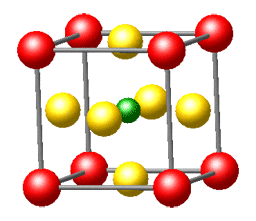
Chair of Solid-State and Quantum Chemistry
Welcome to the Chair of Solid-State and Quantum Chemistry at RWTH Aachen University, Europe's largest Technical University dating back to the year 1870. The following pages are intended to offer you a short overview of our research and teaching activities in the fields of solid-state and quantum chemistry. If you are interested in these exciting chemical disciplines, you have come to the right place. Stay with us! Don't go away!
HOT: Topological Photoluminescence in a Ternary Tb(III) Cyanamide
Recently, low-dimensional lanthanide-based systems have received particular attention for their interesting magnetic and luminescent properties. We present the synthesis of a stoichiometric Tb(III) cyanamide which crystallizes in an orthorhombic structure where the magnetic Tb3+ ions are arranged in well-separated one-dimensional chains parallel to the c axis. Luminescence studies show phosphor-like behavior with a process of energy migration probed to be one-dimensional due to the large difference in the size of the intra- and interchain transfer probabilities. A long luminescent lifetime of 1.22 ms was observed at 100 K. In contrast, AC magnetic susceptibility studies reveal a slow magnetic relaxation process, with a relaxation time of 4.03 μs, thus establishing a good correlation between the compound’s 1D structure and its luminescent and magnetic properties.
DOI:10.1021/acs.chemmater.4c03264
HOT: Orbital-Based Bonding Analysis in Solids
There is certainly no doubt about the quantum character of the atomistic world, most straightforwardly calculated by using wave mechanics and Schrödinger's fundamental equation. The paramount importance of the wave function remains unchanged, and the wave function is most conveniently approximated by a combination of orbitals, for atoms, molecules, and also solids. And it is precisely this “orbital basis” that serves as a gateway to understanding the very interactions that cause atoms to condense into solids. The analysis of quantum-chemical interactions and the nature of the chemical bonding between atoms in solids by use of orbitals is the topic in this perspective. As electronic structures for periodic solids are most often calculated using plane waves, for simple reasons of translational symmetry and Bloch's fundamental theorem, a unitary transformation to atomic or molecular orbitals is needed for final inspection, technically solved by the LOBSTER quantum-chemistry package. It allows for the calculation of wave function-based atomic charges, various population analyses and periodic bonding indicators, first-principles bond orders, two- and multi-centre bonding analysis, fragment-molecular analysis, and a lot more. All those techniques are illustrated from three solid-state systems deriving from carbonate chemistry.
DOI:10.1039/D5SC02936H
HOT: Anderson’s negative-U chemistry in amorphous silicon nitride
P. W. Anderson introduced a negative-U (i.e., attractive electron-electron interaction) to describe the scarcity of singly occupied spin states in amorphous materials. To uncover the underlying chemistry behind this phenomenon, we combined structural sampling with quantum-chemical analysis of amorphous silicon nitride (a-SiNx) based on DFT. Our analysis demonstrates that coordination defects act as charge traps, with a density on the order of 1021 per cubic centimeter. These defects render singly occupied electronic states energetically less favorable than paired or fully emptied states, primarily due to electron donor-acceptor interactions. Furthermore, excess charge trapping occurs through chemical bond reorganization, which disrupts the balance of existing electron and hole traps. In addition, we found that in Si-rich a-SiNx, various Si-Si bonding networks exhibit power-law–like size distribution, where larger networks are associated with deeper trap levels. These findings explain why a-SiNx has been used as a charge storage layer in the charge trap flash memory.
DOI:10.1126/sciadv.adx9540
Solid-State Chemistry

Here's the message: We honestly believe that solid-state chemistry is one of the most exciting chemical disciplines. This fundamental brand of the chemical sciences brings us into contact with a large part of the "real world" surrounding us, and a creative solid-state chemist is in true command of the entire periodic table when he or she decides to make new compounds with often unforeseeable but exciting physical properties. Solid-state chemistry is truly interdisciplinary and borders with solid-state physics, crystallography, quantum theory, metal science, and inorganic chemistry, to name but a few; also, it is one of the rock-solid platforms on which the increasingly popular fields of nanoscience and nanomaterials may be built.
Some of the breathtaking technological advances of the 20th, and also the early 21st century, would have been totally impossible without the fundamental research originating within solid-state chemistry, for example cleverly designed insulators such as dielectric ceramics for data transmission, novel ionic conductors for energy storage in hand-held electrical devices, magnetic intermetallics and oxides for data storage applications, advanced nitrides for electro-optical and diverse mechanical purposes, and also superconductors for energy transport and communication applications. In addition, there is also curiosity-driven research in solid-state chemistry, touching upon chemical systems you probably have never heard of. Interested? Read more about our research to become addicted...
Teaching
 No research today? The teaching section is intended to inform chemistry (and other) students about the various chemistry courses offered by this chair at the Institute of Inorganic Chemistry. No research today? The teaching section is intended to inform chemistry (and other) students about the various chemistry courses offered by this chair at the Institute of Inorganic Chemistry.
|
Computational Chemistry

Computational chemistry is an ingenious, non-experimental way to solve chemical problems by means of sheer computation on the basis of hard-core numerical methods (which are typically quantum-chemical in nature), and this approach has become an increasingly important part of the chemical sciences. Our group specializes in the quantum chemistry of solids (well, that's not too surprising) and we surely know how to solve Schrödinger's equation for periodic systems. In fact, there has been huge progress in properly describing the whole universe of solid-state materials (insulators, semiconductors, metals, and intermetallic compounds) by electronic-structure theory; in addition, predictive conclusions are now in our own hands.
While the numerical methods of ours include very different quantum-chemical tools, their varying levels of accuracy and speed are due to differences in the atomic potentials and the choice of the basis sets involved. The latter may either be totally delocalized (plane waves) or localized (atomic-like), adapted to the valence electrons only (pseudopotentials) or to all the electrons. In order to understand structures and compositions, the results of electronic-structure theory are investigated in terms of further quantum-chemical bonding analyses. There are also cases where one would like to know more about the dynamical behavior of the various atoms, and then the time evolution of their spatial coordinates (that is, their "trajectories") must be calculated as a function of the macroscopic temperature, for example by molecular-dynamics approaches. Go to our research section to learn more about theory and computation. It's fun!
Location
 Although the history of Aachen reaches back to Roman times about 2,000 (and more) years ago, RWTH Aachen University is relatively young for European (not American) standards since it was founded at the end of the 19th century, at the peak of the industrial revolution. Today, RWTH Aachen University is Europe's largest technical university with very famous engineering schools, and its national as well as international reputation also goes back, in part, to its chemistry division. Find out more about our location and our laboratories. If you come from outer space, you may prefer to have a look at our institute from the sky using Google Earth (see top of page). Although the history of Aachen reaches back to Roman times about 2,000 (and more) years ago, RWTH Aachen University is relatively young for European (not American) standards since it was founded at the end of the 19th century, at the peak of the industrial revolution. Today, RWTH Aachen University is Europe's largest technical university with very famous engineering schools, and its national as well as international reputation also goes back, in part, to its chemistry division. Find out more about our location and our laboratories. If you come from outer space, you may prefer to have a look at our institute from the sky using Google Earth (see top of page).
|
|

 Impressum und Datenschutzerklärung (Imprint and Privacy Policy) |
Administration |
Print
Impressum und Datenschutzerklärung (Imprint and Privacy Policy) |
Administration |
Print



